The India story flies on Icarus’ wings
Many indicators suggest the economy may be on the verge of picking up momentum. But an equal number of factors are also lined up to slam the brakes on it.
Good morning! A big hello to readers who signed up this week. Welcome to The Intersection, The Signal's weekend edition. Indian equity indices have been setting new records in the past few weeks as foreign as well as domestic investors turned long-term bulls on the country’s economy. But it has not shown sustained growth. Private consumption is yet to pick up and exports are declining. It may not take long for sentiment to sour. Plus, we've shared a list of long reads for you.
The Signal is now on Telegram! We've launched a group — The Signal Forum — where we share what we’re reading and listening through the day. Join us to be a part of the conversation!
If you enjoy reading us, why not give us a follow at @thesignaldotco on Twitter Instagram and Threads.
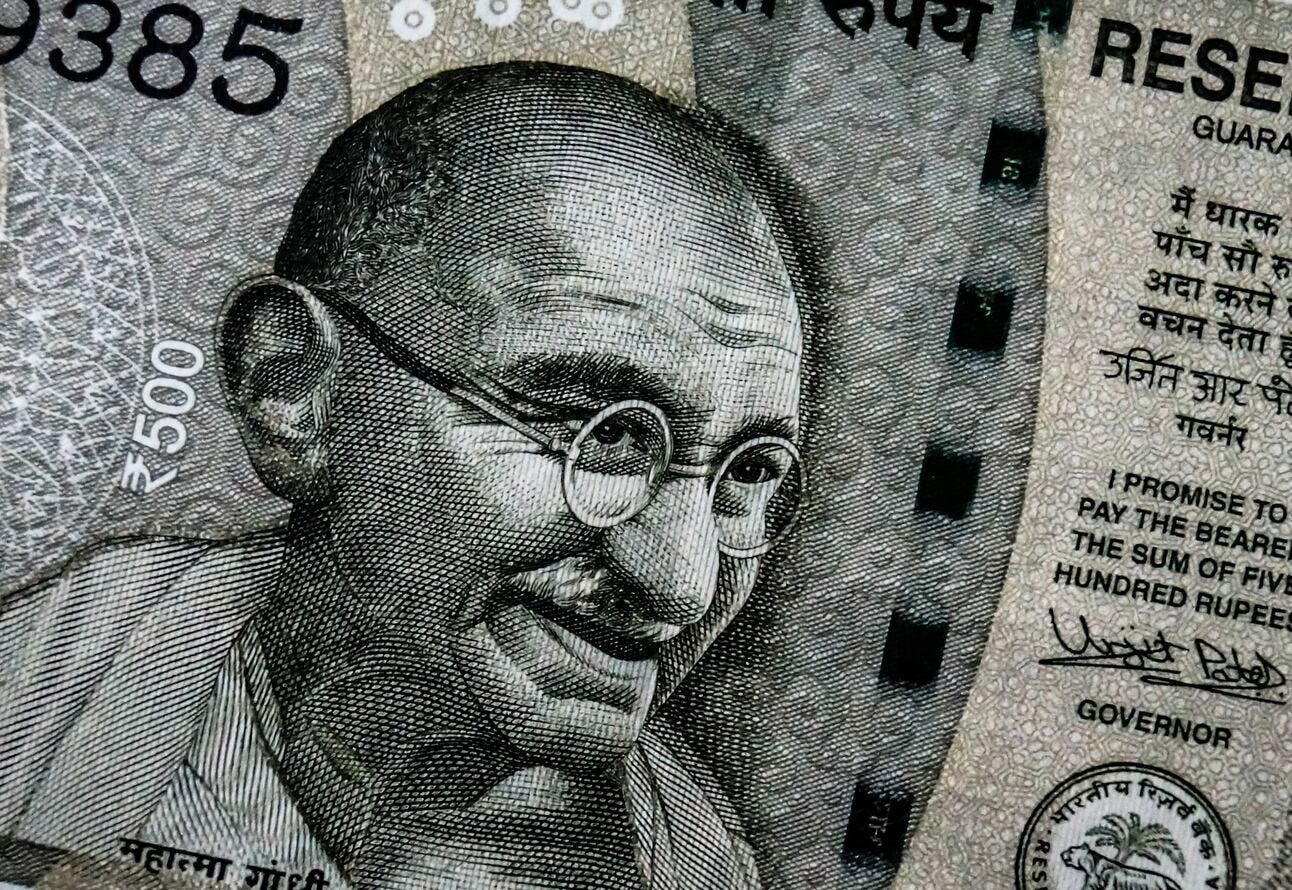
Photo by Ishant Mishra on Unsplash
According to an ancient Greek myth, Daedalus made wings out of feathers and wax for his son Icarus and himself to fly out of prison. Daedalus instructed Icarus to fly neither too low, lest the moisture from the sea clog his wings, nor too high for the sun to melt the beeswax.
Indian equities seem to have taken Daedalus’ first advice quite seriously.
Benchmarks left behind the doldrums of 2022 (we call it the curse of the second year of the decade), rising rapidly in the past five months. By late July, the National Stock Exchange’s Nifty and the Bombay Stock Exchange’s Sensex were setting new lifetime records. The 10% rise in the first quarter of 2023-24 was the steepest quarterly gain since July-September 2021, when the Nifty rose 12.1%.
Post-pandemic global economic recovery was rudely broken by the Russia-Ukraine war, which continues unabated. The war not only upended international political ties but also ripped apart global trade and economic relations, rearranging them in a new matrix where India found itself in a sweet spot. It emerged as a democratic and economic counterweight to Russia’s BFF China, whose growing military and economic power rattled western countries reckoning with unprecedented economic headwinds. It birthed the ‘China+1’ investment diversification and de-risking strategy, helping India position itself as the most viable alternative with a huge domestic market, enviable talent pool, decent manufacturing capability and business-friendly government.
“India is arguably at the start of a long wave boom at the same time as China may be ending one,” financial services giant Morgan Stanley said in an August 2 equity research report advising clients to go overweight on India while downgrading Australia, China, and Taiwan.
Calling India its most preferred emerging market, the firm said it was enthused by the fact that Indian households' debt as a percentage of GDP was just 19% compared with 48% of China. Only 2% of them had life insurance, hinting at the growth opportunity. It cited macroeconomic stability, positive earnings outlook, steady foreign investor flows, and a young population among the country’s advantages.
Foreign portfolio investors’ (FPIs) have ploughed in a net $18.5 billion so far in FY24. June inflows were the highest in 10 months.
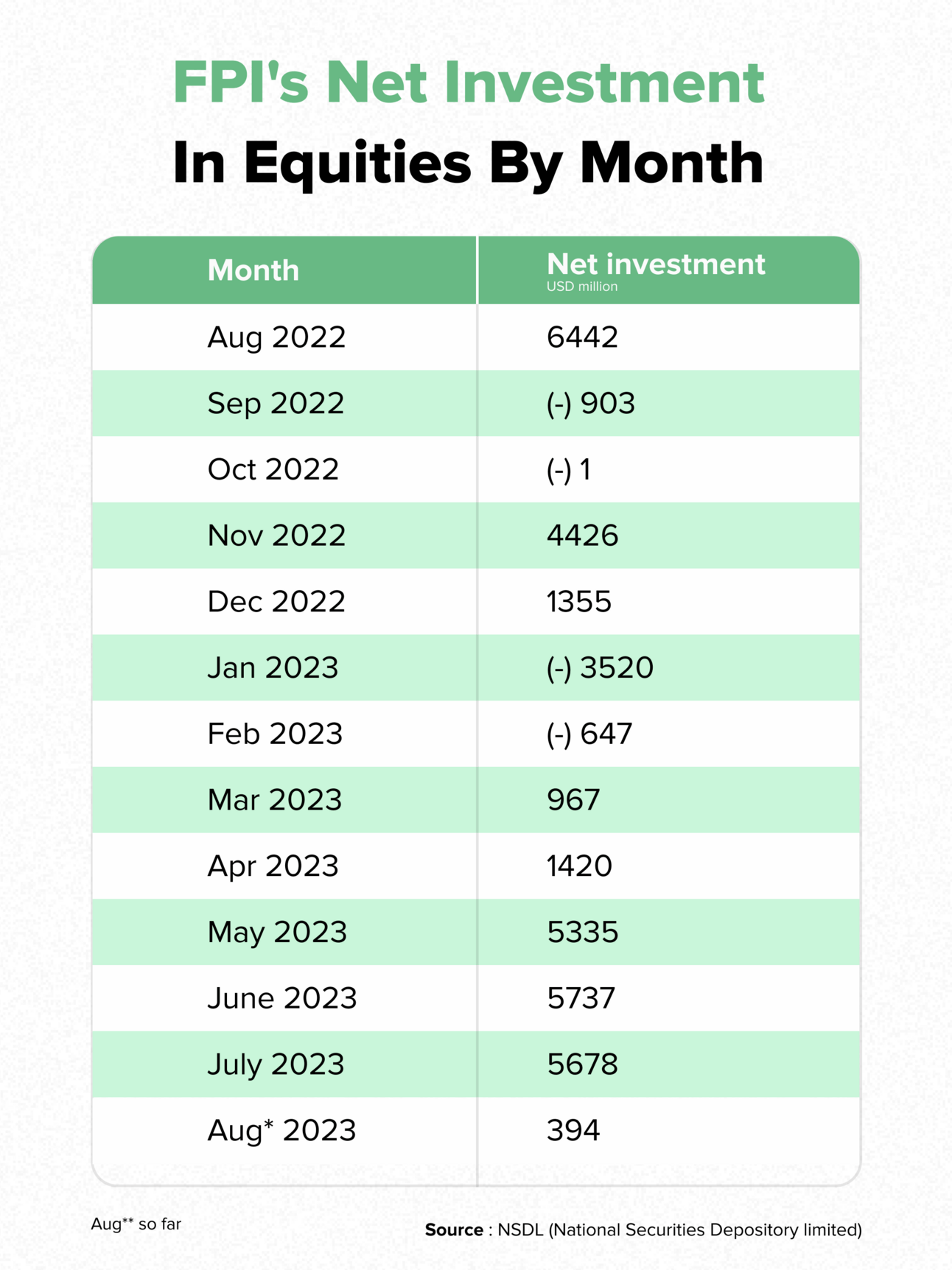
Credit: Harish Arjun
“From 5,000 miles away, India is looking really good,” the India analyst of a US financial services firm, who did not wish to be named, told The Intersection.
Matching foreign investors' enthusiasm, domestic investors are also rushing to equities. The rising popularity of systematic investment plans has ensured a steady flow of money into mutual funds, which now manage ₹45 lakh crore (~$544 billion) in assets.
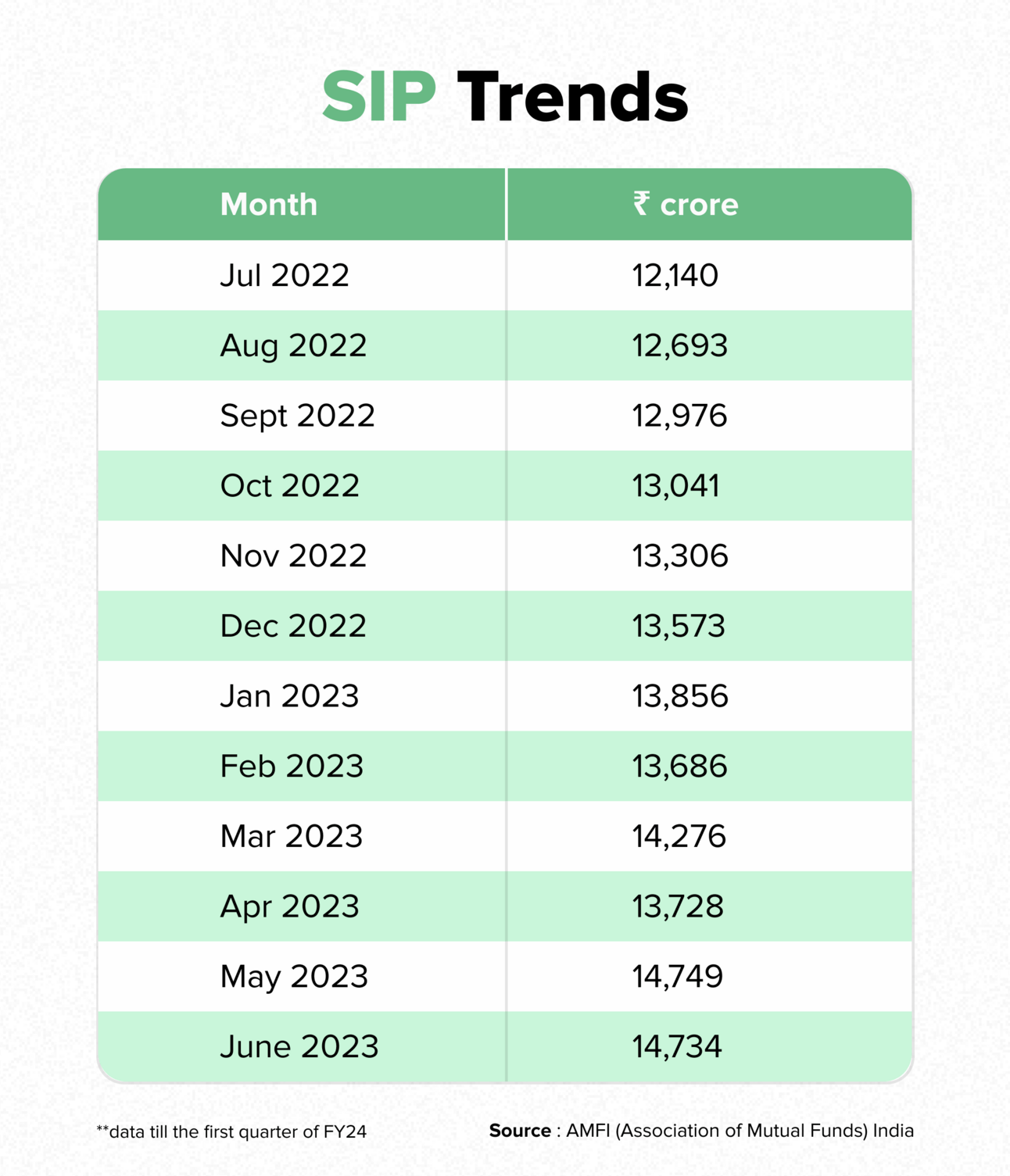
Credit: Harish Arjun
The value proposition
India’s long-term growth story has captivated investors to such an extent that they have already priced in expected corporate earnings for the next two years.
“Any equity market is valued on a long-term basis. It is not just about growth but also about the longevity of the cycle,” Rajat Agarwal, Asia Equity Strategist at Societe Generale, told The Intersection.
“Given India’s demographic outlay, the tipping point for growth is perhaps very far away,” Agarwal said. “It isn’t about whether it delivers on growth now or not, it is about the growth story for the next 30-40 years.”
Broking firm Motilal Oswal expects the 50 Nifty companies to grow at an average of 20% in FY24. The firm estimates that the profit-to-GDP ratio for Nifty’s top 500 companies (that account for 90% of market capitalisation) slipped marginally to 4.1% in FY23 from a decade high of 4.3% in FY22. Their profits were stagnant at ₹4 trillion-₹5 trillion (~$48 billion-$60 billion) between 2014 and 2020, but jumped to ₹10.2 trillion-₹11.1 trillion (~$121 billion-$134 billion) in 2022-23. But that growth has come from better margins and not expanding sales.
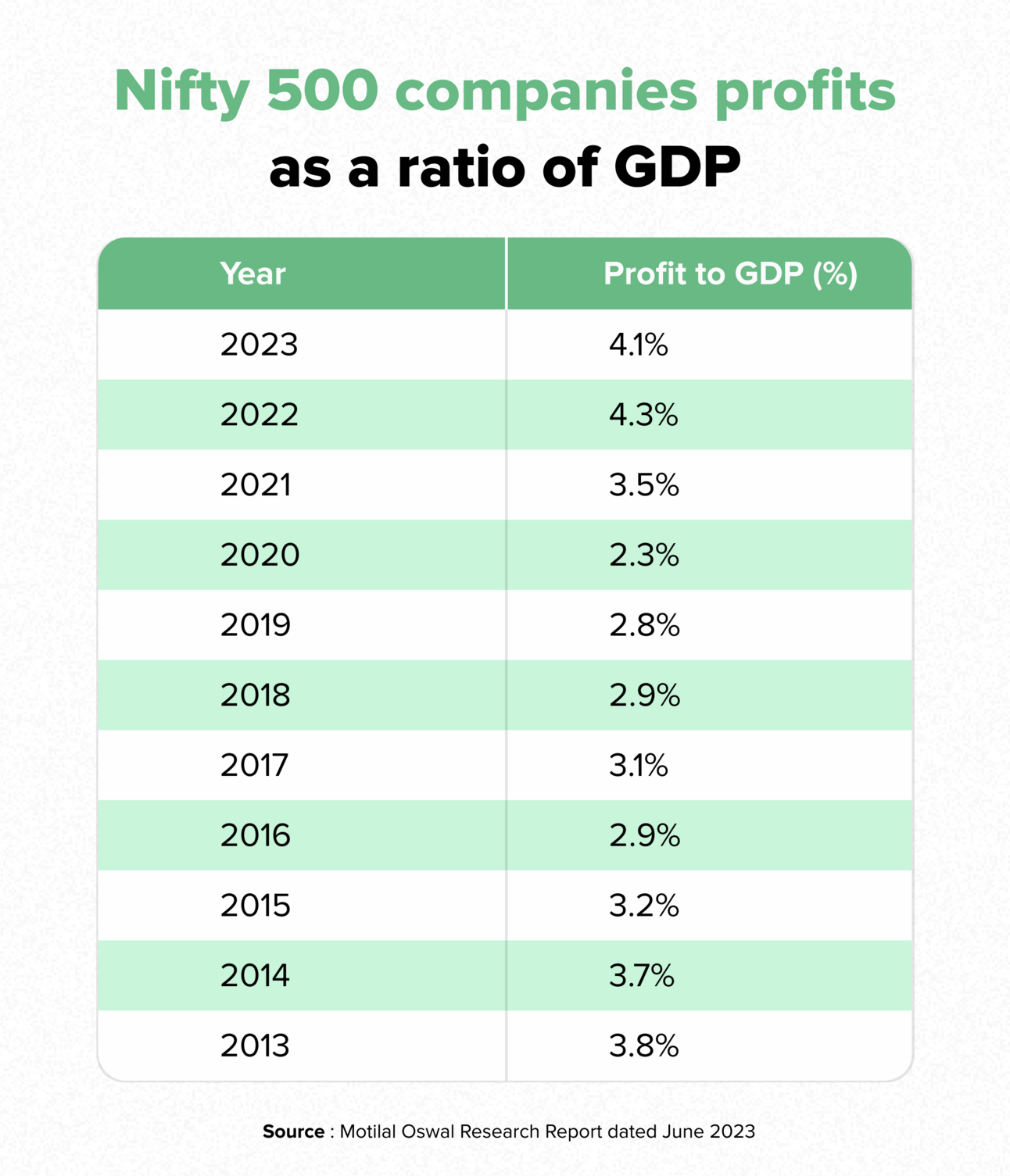
Credit: Harish Arjun
Although there are sporadic signs of economic activity picking up, momentum is missing. A few segments of the economy such as oil and gas, metals, and power are reporting rising capital expenditure.
Abheek Barua, chief economist at HDFC Bank, told The Intersection that anecdotal evidence as well as credit data showed some small and medium companies building capacity in anticipation of demand from larger companies they supply to. That inverts the usual trend of downstream companies adding capacity when upstream firms increase orders based on rising demand.
India is also the biggest market for sub-$100 million public offers this year. Ninety-two companies have sold shares to the public, with one tiny snackmaker, Sonalis Consumer Products, raising as little as ₹2.83 crore (~$3,50,000) in an initial public offer.
Local investors are betting on small companies too. They pumped in a record ₹5,472 crore (~$660 million) into small cap funds in June, which was two-thirds of the total flows into mutual funds in that month. As a result, small cap stocks have risen to an extent where the risk-to-reward ratio is nearly at par with large cap stocks. Ideally, the growth rate in small cap stocks should be higher than that in large cap stocks to compensate the holder for higher risk.
The volume of domestic holdings has risen so much that even after pumping in nearly $15.364 billion into equities in 2023, FPIs’ overall share has been declining and now stands at 17%.
The pattern of investments shows an inclination towards manufacturing stocks or infrastructure stocks as opposed to consumption sector stocks. Global supply chains’ China+1 strategy, some of Apple’s manufacturing moving to India, Tesla’s imminent arrival, and a host of other industries that are looking to set up base in the country are adding to the allure.
“I think India is making a strong pitch from a global capital-attracting standpoint where it is trying to move away from being a pure services-driven economy to making an attempt to enter into the domain of manufacturing and using a large part of free capital to also build infrastructure,” Shobhit Mathur, Senior Director at Kotak Cherry, said.
Mathur says foreign investors are seeing positive changes, from rapid infrastructure building and industrial policies to forex reserves and allocation of capital. “If any of those get disrupted, flows can get reversed and that could have a snowball effect.”
An RBI survey in April showed that existing capacity in the manufacturing sector was being utilised at a robust 74.3% in October-December 2022, up from 74% in the previous quarter. Utilisation holding above the 72% mark for two consecutive quarters indicates brisk manufacturing activity that could require fresh capacity soon.
The big K
The post-pandemic Indian consumption story bifurcates into two paths, or the ‘K’ shape if you will.
While sales of luxury homes, premium vehicles, and high-end gadgets are booming, demand for goods consumed by those with modest or low incomes is tepid. Therein lies the story of rising inequality. The Economic Times reports that producers are tweaking their portfolios, prioritising the premium segment at the cost of entry level customers.
There are only half the sub ₹10-lakh car models in the market now compared to 2019, while the number of models costing more than ₹10 lakh doubled in the past three years. More than 100 out of 170 television models launched in 2023 boasted screens above 50 inches. More than two-thirds of laptops launched this year had a price tag of ₹50,000 or more, while that proportion was less than half in 2019.
India’s GDP rose by a more-than-expected 6.1% in January-March and manufacturing profit margins widened, but private consumption was muted at 2.8%. Economists at multilateral institutions, the RBI, and private sector analysts peg India’s GDP growth to be between 6% and 7% in the next couple of years. Much of that will be on the strength of the domestic market.
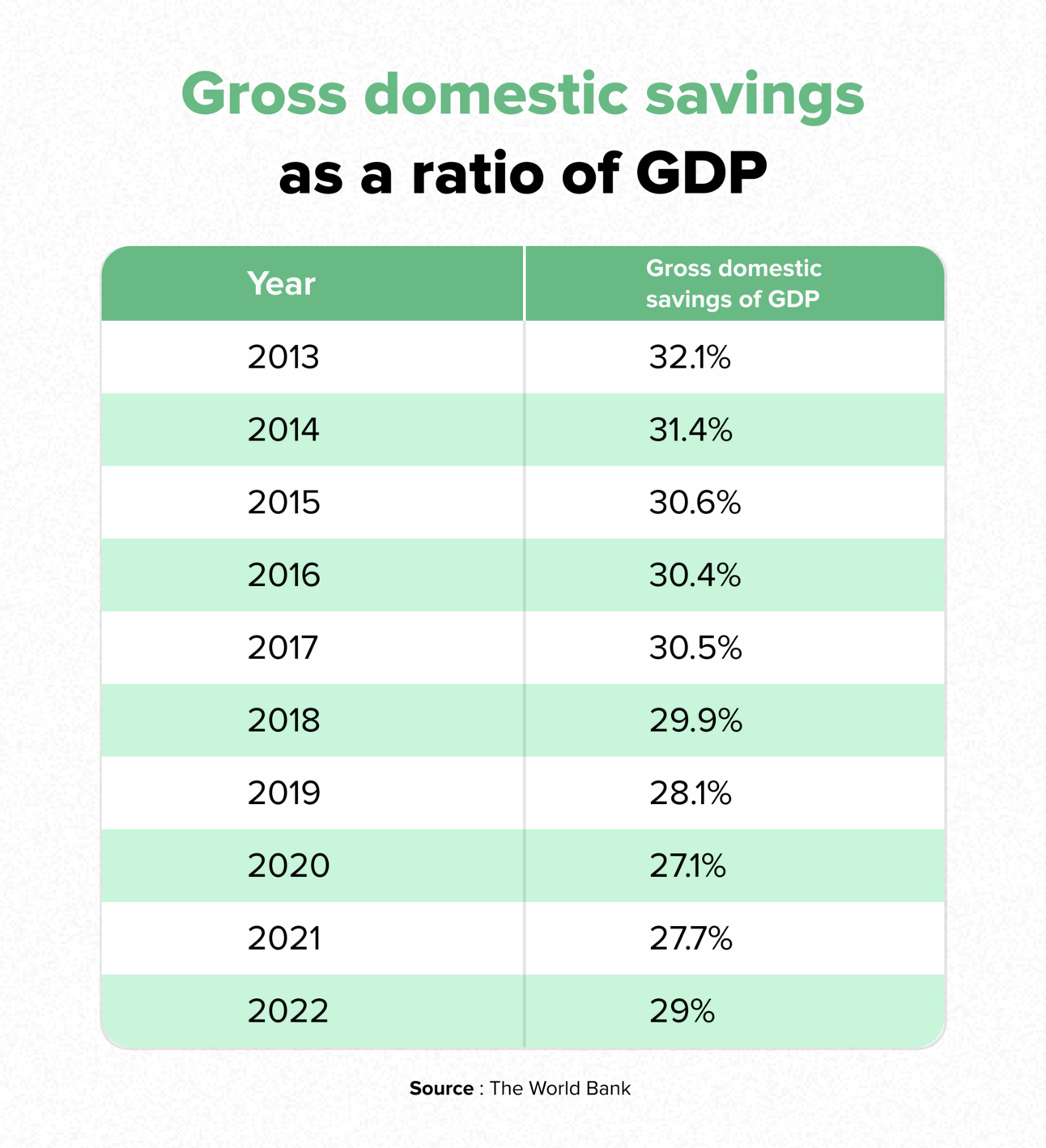
There has been an uptick in rural demand but it is not uniform, as is evident from FMCG sales. Rural demand accounts for 40% of FMCG companies’ revenues. While Dabur saw some green shoots, Marico and HUL reported sluggish sales in the rural market. Some of it could also be attributed to the rise of direct-to-consumer brands and unorganised local players in certain categories.
Real rural wages contracted for the 16th consecutive month till March, and preliminary data from the rural development ministry showed that more people gravitated towards the government-run rural jobs guarantee programme in June in the absence of meaningful employment opportunities.
“The foundation is in place but there needs to be visibility on demand as well. Which is not there today,” Saion Mukherjee, Managing Director and Head of India Equity Research at Nomura, told The Intersection.
Private consumption is expected to pick up during the festival season. Staffing firms are anticipating companies to hire up to 700,000 temporary workers between August-end and December to meet festival demand. In a report, Deutsche Bank points out that real wages have largely remained flat. Average real rural wages slipped as inflation ate into meagre earnings.
“The tech sector, one of the big employers in urban consumption, is looking quite wobbly, and the BFSI is not a net absorber of new entrants to the workforce. These are all risks to consumption, but if you look at the Morgan Stanley view, it takes a slightly medium-term call,” HDFC Bank’s Barua says.
A report by an independent non-profit think tank, PRICE, points out that only 20% of total Indian households accounts for 55.5% of total household income.
Speaking to The Intersection, PRICE managing director Rajesh Shukla said nearly 10% Indians (higher than 8% residing in metros) living in developed rural areas have a share of 23% in incremental consumption. The bottom 40% of the economy, though, suffers from the lingering effects of the pandemic.
“They had exhausted their savings on medical expenses during Covid. They may also have borrowed for subsistence,” says Shukla. He says now their earnings are going into meeting daily expenses, repaying debt, or building minimum savings.
There are also signs that household financial health is deteriorating. Broking firm Motilal Oswal estimates that in 2009-10 and 2010-11, a year’s savings were enough to pay off all household debts. In 2021-22, it would take 1.8 times a year’s worth of savings to become debt free. Outstanding credit card payments crossed ₹2 lakh crore (~$24 billion) for the first time. Retail credit doubled to ₹41 lakh crore (~$495 million) in the five years to March 2023. An RBI analysis found that nearly a third of home loan borrowers had negative financial margin, meaning they had barely any money left after paying EMIs.
“In highly unequal economies, finance and real estate become the central economic drivers,” writes Ashoka Mody, visiting professor of International Economic Policy at Princeton University, US. That trend is visible in the fintech gold rush as new age firms as well as traditional lenders chase consumers to borrow and spend more.
Missing kicker
Historically, India has thrived on export performance to deliver the extra growth that generated jobs and livelihoods on a large scale. Exports accounted for about a third of GDP growth in every decade since the 1990s, Arvind Subramanian, India’s former chief economic advisor, and Shoumitro Chatterjee, assistant professor of economics at Pennsylvania State University, wrote in a 2020 analysis. India was the third top exporter in the world between 1995 and 2018 in terms of growth, averaging 13.4% annually. Manufacturing exports in that period grew 12.1% on average. Every 5% export growth foregone shaves off 1% from GDP growth, the economists wrote.
In comparison, India’s exports have been decelerating in FY24. They fell 12.7% in April, 5.99% in May and 13.6% in June.
Princeton’s Mody writes in the Financial Times that the Indian rupee is overvalued and only a cheaper currency can spur export growth. He writes that India is at a cost-of-production disadvantage compared to rivals and to compensate, the rupee should drop to at least 90 to a dollar. A weak rupee, however, is considered a symbol of national weakness.
While waiting for the ideal confluence of factors to spur on growth momentum, all one can do is pay heed to Daedalus’ warning: shun both complacency and hubris.
ICYMI

Succession battle: Vast wealth more often than not becomes contentious in large families. So it is in one of the wealthiest families of North India. Sita Chaudhry is the 90-year-old matriarch of one of the twin branches of the DLF business groups’ founding family. She is the widow of Chaudhry Devinder Singh, the younger brother of Chaudhry Raghavendra Singh, who founded DLF, American Universal Electric (AUE), and Industrial Cables Ltd (ICL). Raghavendra bestowed AUE to his son-in-law, KP Singh, and ICL to his younger brother, Devinder. Although ICL has fallen on bad times, it, along with group companies, owns vast properties in Punjab, Chandigarh, Mumbai, and Delhi. Sita Chaudhry has gone to court alleging that her eldest granddaughter, Sunaina Singh, wormed her way into her home and business, eventually duping her into signing off most of her ownership in the business and properties worth an estimated ₹1,500 crore (~$181 million). The Economic Times writes that the entire Chaudhry family appears to be ranged against Sunaina Singh, her husband, and in-laws, who now have complete control over everything that belonged to the family.
Metamorphosis: What happened to the transgressive artist behind the stellar albums Visions, Art Angels, and Miss Anthropocene? She’s open-sourced her IP and now wants to be a self-replicating AI propaganda machine for Mars. Her words, not ours. In this freewheeling interview with WIRED, Grimes, real name Claire Boucher—who also goes by ‘c’, as in the speed of light—chats about everything from motherhood to Vivaldi. For all her quirks and problem areas coughElonMuskcough, Grimes is a great interviewee. For one, it’s refreshing to see someone who’s a stubborn techno-optimist amid the techno-pessimism. Two, she has some batsh*t ideas. We won’t tell you what they are; what we will say, though, is that we miss the (old) Grimes who put cyborg pop on the map.
Searching for The Professor: In Netflix’s Money Heist, a criminal mastermind called The Professor puts together a team to loot Spain’s Royal Mint. In 2018 in Pune, a similar team of money mules, middlemen, and masterminds looted ₹94.42 crore (~$11.5 million) from Cosmos Bank. How did they pull off India’s biggest bank heist? This story in the Economic Times breaks it down from the police’s POV. Investigators spent years combing CCTV footage, SIM card data, and transaction histories to discover a sophisticated crime that went beyond siphoning cash from ATMs with cloned credit cards. The masterminds used repeated phishing attacks to gain access to Cosmos Bank’s systems, stayed in it for several months, and injected malware that overrode the bank’s ID and safety mechanisms. Given the complexity, cops believe North Korean hackers planned it all (!). And yes, The Professor in this instance hasn’t been caught yet.
What happened to Vishal?: July 29, 1981. An estimated 750 million people around the world tuned in to watch the wedding of Prince Charles and Lady Diana Spencer. For Londoners like the Mehrotra family, the royal wedding was an unforgettable local event, especially for their son Vishal. But celebration turned into tragedy. The eight-year-old went missing on his way back home; seven months later, his remains were found in West Sussex. Nobody knows what happened, and there have been no convictions. BBC podcast Vishal plumbs the depths of the 42-year-old cold case that haunts the Mehrotra family, and a botched investigation that says plenty about the attitudes towards South Asians in the 1980s UK.
Who runs the world?: In Iran, it’s mandatory for women to wear the hijab. But since last year, it has become a powerful symbol in the country’s anti-government protests. The death of a young woman, Mahsa Jina Amini, while in custody has united women across towns and cities in protest, making it one of the greatest challenges to Iran's political establishment since the 1979 Islamic Revolution. And it’s not just adult women. Iranian schoolgirls are at the forefront, too. In one instance, students refused to wear the veil and scribbled slogans such as “Women, life, freedom” and “Death to the dictator” on desks and bathroom walls. Elsewhere, a group of schoolgirls tore down portraits of the country's past and present Supreme Leaders, and scribbled across their faces. These actions are not without casualties. Earlier this year, some Iranian schoolgirls were “poisoned”. Undaunted, they’re still fighting for their rights despite proactive attempts to silence them. This feature in The New Yorker highlights how young women are now in open defiance of the regime.
India’s tech one-percenters: What’s the common thread between Sundar Pichai (CEO of Google), Parag Agrawal (former CEO of Twitter), Nikesh Arora (former COO of SoftBank), Vinod Khosla (co-founder of Sun Microsystems), and Arvind Krishna (CEO of IBM)? Apart from the fact that they’re all Silicon Valley success stories, of course. They’re all IIT graduates. The Indian Institutes of Technology are now among the world’s top schools. With an acceptance rate of just 1.83%, they’re more selective than any Ivy League university. And becoming an IITian is often a ticket to tech success. Of India’s 108 unicorns, 68 were founded by an IIT graduate. As the list above shows, it’s not restricted to India. What’s the secret behind the IITs’ success? Check out this deep dive in Rest of World.



